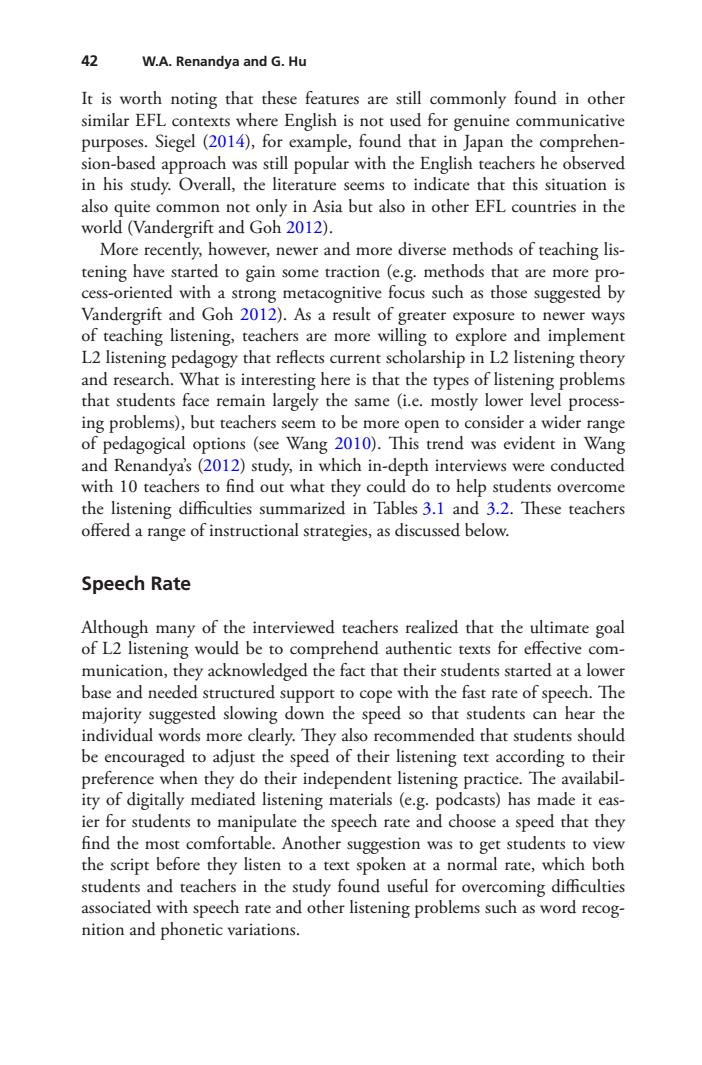正在加载图片...

42 W.A.Renandya and G.Hu It is worth noting that these features are still commonly found in other similar EFL contexts where English is not used for genuine communicative purposes.Siegel (2014),for example,found that in Japan the comprehen- on-based approach was still popular with the English teachers he observed in his study.Overall,the literature seems to indicate that this situation is also quite common not only in Asia but also in other EFL countries in the world (Vandergrift and Goh 2012). More recently,however,newer and more diverse methods of teaching lis- tening have started to gain some traction (gmethods that are more pro- cess-oriented with a strong metacognitive focus such as those suggested by Vandergrift and Goh 2012).As a result of greater exposure to newer ways of teaching listening,teachers are more willing to explore and implement L2 listening pedagogy that reflects current scholarship in L2 listening theory and research.What is interesting here is that the types of listening problem that students face remain largely the same (i.e.mostly lower level process- ing problems),but teachers seem to be more open to consider a wider rang of pedagogical options (see Wang 2010).This trend was evident in Wang and Renandya's(2012)study,in which in-depth interviews were conducted with 10 teachers to find out what they could do to help students overcome the listening difficulties summarized in Tables 3.1 and 3.2.These teachers offered a range of instructional strategies,as discussed below. Speech Rate Although many of the interviewed teachers realized that the ultimate goal of L2 listening would be to comprehend authentic texts for effective com- munication,they acknowledged the fact that their students started at a lowe base and needed structured support to cope with the fast rate of speech.The majority suggested slowing down the speed so that students can hear the individual words more clearly.They also recommended that students should be encouraged to adjust the speed of their listening text according to their preference when they do their independent listening practice.The availabil- ity of digitally mediated listening materials (e.g.podcasts)has made it eas- ier for students to manipulate the speech rate and choose a speed that they find the most comfortable.Another suggestion was to get students to viev the script before they listen to a text spoken at a normal rate,which both students and teachers in the study found useful for overcoming difficulties associated with speech rate and other listening problems such as word recog- nition and phonetic variations.42 W.A. Renandya and G. Hu It is worth noting that these features are still commonly found in other similar EFL contexts where English is not used for genuine communicative purposes. Siegel (2014), for example, found that in Japan the comprehension-based approach was still popular with the English teachers he observed in his study. Overall, the literature seems to indicate that this situation is also quite common not only in Asia but also in other EFL countries in the world (Vandergrift and Goh 2012). More recently, however, newer and more diverse methods of teaching listening have started to gain some traction (e.g. methods that are more process-oriented with a strong metacognitive focus such as those suggested by Vandergrift and Goh 2012). As a result of greater exposure to newer ways of teaching listening, teachers are more willing to explore and implement L2 listening pedagogy that refects current scholarship in L2 listening theory and research. What is interesting here is that the types of listening problems that students face remain largely the same (i.e. mostly lower level processing problems), but teachers seem to be more open to consider a wider range of pedagogical options (see Wang 2010). Tis trend was evident in Wang and Renandya’s (2012) study, in which in-depth interviews were conducted with 10 teachers to fnd out what they could do to help students overcome the listening difculties summarized in Tables 3.1 and 3.2. Tese teachers ofered a range of instructional strategies, as discussed below. Speech Rate Although many of the interviewed teachers realized that the ultimate goal of L2 listening would be to comprehend authentic texts for efective communication, they acknowledged the fact that their students started at a lower base and needed structured support to cope with the fast rate of speech. Te majority suggested slowing down the speed so that students can hear the individual words more clearly. Tey also recommended that students should be encouraged to adjust the speed of their listening text according to their preference when they do their independent listening practice. Te availability of digitally mediated listening materials (e.g. podcasts) has made it easier for students to manipulate the speech rate and choose a speed that they fnd the most comfortable. Another suggestion was to get students to view the script before they listen to a text spoken at a normal rate, which both students and teachers in the study found useful for overcoming difculties associated with speech rate and other listening problems such as word recognition and phonetic variations